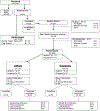GERI-BD: A Randomized Double-Blind Controlled Trial of Lithium and Divalproex in the Treatment of Mania in Older Patients With Bipolar Disorder
- PMID: 29088928
- PMCID: PMC6214451
- DOI: 10.1176/appi.ajp.2017.15050657
GERI-BD: A Randomized Double-Blind Controlled Trial of Lithium and Divalproex in the Treatment of Mania in Older Patients With Bipolar Disorder
Abstract
Objective: Clinicians treating older patients with bipolar disorder with mood stabilizers need evidence from age-specific randomized controlled trials. The authors describe findings from a first such study of late-life mania.
Method: The authors compared the tolerability and efficacy of lithium carbonate and divalproex in 224 inpatients and outpatients age 60 or older with bipolar I disorder who presented with a manic, hypomanic, or mixed episode. Participants were randomly assigned, under double-blind conditions, to treatment with lithium (target serum concentration, 0.80-0.99 mEq/L) or divalproex (target serum valproate concentration, 80-99 μg/mL) for 9 weeks. Participants with an inadequate response after 3 weeks received open adjunctive risperidone. The authors hypothesized that divalproex would be better tolerated and more efficacious than lithium. Tolerability was assessed based on a measure of sedation and on the proportions of participants achieving target concentrations. Efficacy was assessed with the Young Mania Rating Scale (YMRS).
Results: Attrition rates were similar for lithium and divalproex (14% and 18% at week 3 and 51% and 44% at week 9, respectively). The groups did not differ significantly in sedation. Participants in the lithium group tended to experience more tremor. Similar proportions of participants in the lithium and divalproex groups achieved target concentrations (57% and 56%, respectively). A longitudinal mixed model of improvement (change from baseline in YMRS score) favored lithium (change in score, 3.90; 97.5% CI=1.71, 6.09). Nine-week response rates did not differ significantly between the lithium and divalproex groups (79% and 73%, respectively). The need for adjunctive risperidone was low and similar between groups (17% and 14%, respectively).
Conclusions: Both lithium and divalproex were adequately tolerated and efficacious; lithium was associated with a greater reduction in mania scores over 9 weeks.
Trial registration: ClinicalTrials.gov NCT00254488.
Keywords: Bipolar; Divalproex; Late-life; Lithium; Mania.
Figures


Comment in
-
Treatment of Bipolar Disorder in the Elderly.Am J Psychiatry. 2017 Nov 1;174(11):1032-1033. doi: 10.1176/appi.ajp.2017.17070762. Am J Psychiatry. 2017. PMID: 29088940 No abstract available.
References
-
- Bartels SJ, Forester B, Miles KM, Joyce T. Mental health service use by elderly patients with bipolar disorder and unipolar major depression. Am J Geriatr Psychiatry. 2000;8(2):160–6. Epub 2000/05/10. - PubMed
-
- Gildengers AG, Butters MA, Chisholm D, Rogers JC, Holm MB, Bhalla RK, et al. Cognitive functioning and instrumental activities of daily living in late-life bipolar disorder. The American Journal of Geriatric Psychiatry. 2007;15(2):174–9. - PubMed
-
- Shulman KI, Tohen M, Satlin A, Mallya G, Kalunian D. Mania compared with unipolar depression in old age. Am J Psychiatry. 1992;149(3):341–5. Epub 1992/03/01. - PubMed
-
- Bostwick JM, Pankratz VS. Affective disorders and suicide risk. American Journal Psychiatry. 2000;157:1925–32. - PubMed
-
- Kessing LV, Nilsson FM. Increased risk of developing dementia in patients with major affective disorders compared to patients with other medical illnesses. Journal of Affective Disorders. 2003;73 261–9. - PubMed
Publication types
MeSH terms
Substances
Associated data
Grants and funding
LinkOut - more resources
Full Text Sources
Other Literature Sources
Medical

